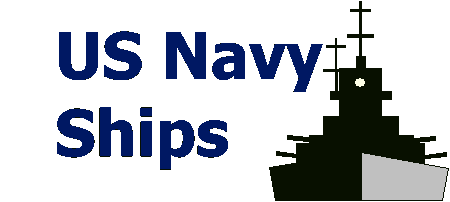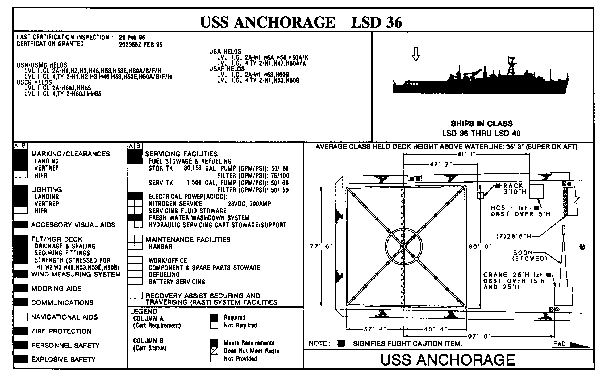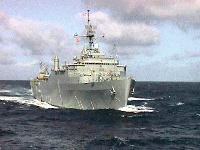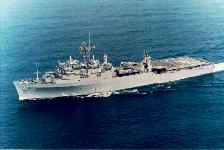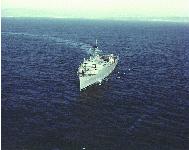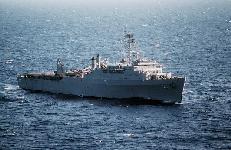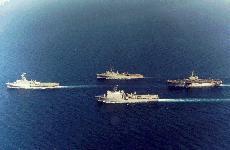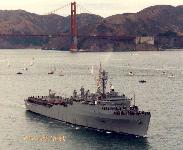LSD-36 Anchorage class - Navy Ships (original) (raw)
FAS |Military |DOD 101 |Systems |Ships ||||
Dock Landing Ships support amphibious operations including landings via Landing Craft Air Cushion (LCAC), conventional landing craft and helicopters, onto hostile shores. These ships transport and launch amphibious craft and vehicles with their crews and embarked personnel in amphibious assault operations.
The Anchorage class Dock Landing Ship (LSD) designed to operate as an integral part of a balanced, mobile and modern amphibious strike force. The ship couples a well deck with a flight deck to give greater dimension to the Navy's troop and vehicle lifting capability. Primarily designed to transport pre-loaded heavy landing craft to the shore and discharge them rapidly, the ship is also equipped with machine shops and facilities to provide dry docking and repairs to small boats.
Intrinsic in the well deck operation is a ballasting system that fills the deck with sea water to a depth necessary for loading landing craft such as the LCU and LCAC. The ships are designed to transport and operate heavy landing craft from a large well deck, and have been modified for operations with the Landing Craft Air Cushion (LCAC). USS Mount Vernon was the first West Coast ship to be modified for operations with the Landing Craft Air Cushion (LCAC), used for transportation of personnel and equipment for amphibious operations. Wet well evolutions are facilitated through the use of complex, electro-hydraulically controlled ballasting and deballasting systems. The helicopter landing platform can be used in support of helicopter assaults and logistic operations. The ships' habitability features provide for the berthing, messing and cargo transportation of approximately 300 fully equipped combat troops of the landing force in addition to the 360 crew members assigned. Installed electronic equipment includes air, navigation, and surface search radars, a complete communications suite and an Electronic Emitter Detection System to support the ship's amphibious mission.
Two Anchorage-class LSD-36s will be retired from service by FY 1999.
| Specifications | |
|---|---|
| Power Plant | Two 600 psi boilers, two geared steam turbines, two shafts, 24,000 total shaft horsepower |
| Length | 553 feet (168.6 meters) |
| Beam | 85 feet (25.9 meters) |
| Displacement | 14,000 tons (full load) |
| Speed | 22 knots (25.3 miles per hour, 40.5 km, per hour) |
| Aircraft | None |
| Landing Craft | 3 LCAC Landing Craft, Air Cushion |
| Crew | Ships Company: 18 officers, 340 enlisted Marine Detachment: 330 Departments Deck Engineering Navigation Operations Supply |
| Armament | 4 - 3-inch/50 cal. twin barrel guns2 - 25mm MK 38 Machine Guns2 - 20mm Phalanx CIWS |
| **Unit Operating Cost Annual Average | $20,000,000 [source: [FY1996 VAMOSC] |
| Ships | ||||||
|---|---|---|---|---|---|---|
| Name | Number | Builder | Homeport | Ordered | Commissioned | Decommissioned |
| Anchorage | LSD-36 | Ingalls | San Diego | 29 Jun 1965 | 20 Feb 1969 | ?~ 2000 - 2004 |
| Portland | LSD-37 | Bath [GD] | Little Creek | 25 Feb 1966 | 03 Oct 1970 | ?~ 2000 - 2005 |
| Pensacola | LSD-38 | Bath [GD] | Little Creek | 25 Feb 1966 | 01 Mar 1971 | ?~ 2000 - 2006 |
| Mount Vernon | LSD-39 | Bath [GD] | San Diego | 25 Feb 1966 | 01 Apr 1972 | ?~ 2000 - 2007 |
| Fort Fisher | LSD-40 | Bath [GD] | San Diego | 02 May 1967 | 09 Dec 1972 | 27 Feb 1998 |

Sources and Resources
- FY1996 Ships Class Average Report Navy Visibility and Management of Operating and Support Costs (VAMOSC)
FAS |Military |DOD 101 |Systems |Ships ||||
http://www.fas.org/man/dod-101/sys/ship/lsd-36.htm Maintained by Robert Sherman Originally created by John Pike Updated Wednesday, March 03, 1999 7:33:19 PM



